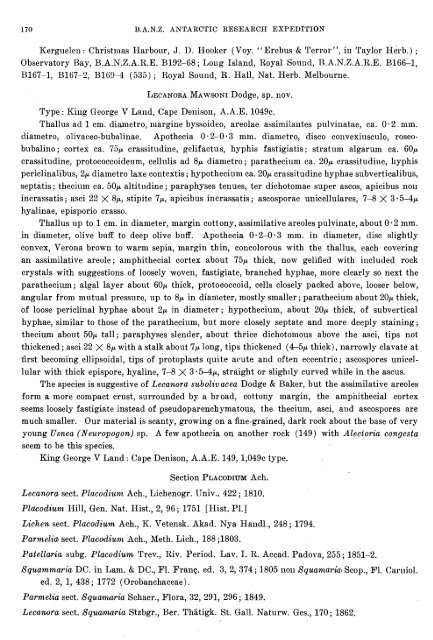You also want an ePaper? Increase the reach of your titles
YUMPU automatically turns print PDFs into web optimized ePapers that Google loves.
170 B.A.N.Z. ANTARCTIC RESEARCH EXPEDITION<br />
Kerguelen : Christinas Harbour, J. D. Hoolter (Voy. "Erebus & Terror", iii Taylor ~ erb.) ;<br />
Observatory Bay, R.A.N.Z.A.R.E. B192-68; Long Island, Royal Sound, B.A.N.Z.A.R.E. B166-1,<br />
B167-1, B167-2, Bl(i9-4 (535) ; Royal Sound, R. Ha.11, Nat. Herb. Melbourne.<br />
LECANORA MAWSONI Dodge, sp. nov.<br />
Type : Kiiig George V Land, Cape Deiiisoii, A.A.E. 1049c.<br />
Thallus ad 1 cm. diarnetro, niargine byssoideo, areolae assimilaiites pulvinatae, ca. 0.2 mm.<br />
diametro, olivaceo-bubalinae. Apothecia 0.2-0.3 mm. diametro, disco coi~vexiusculo, roseobubalino;<br />
cortex ca. 75,~ crassitudine, gelifactus, hyphis fastigiatis; stratum algarum ca. GOp<br />
crassitudine, protococcoideum, cellulis ad 8p diametro; parathecium ca. 20p crassitudine, liyphis<br />
periclinalibus, 2p diametro laxe contextis ; hypothecium ca. 20p crassitudine hyphae subverticalibus,<br />
septatis; thecium ca. 50p altitudine; paraphyses tenues, ter dichotomae super ascos, apicibus no11<br />
incrassatis; asci 22 X 8p, stipite 7p, apicibus incrassatis; ascosporae unicellulares, 7-8 X 3.54,~<br />
hyalinae, episporio crasso.<br />
Thallus up to 1 cm. in diameter, margin cottony, assimilative areoles pulvinate, about 0.2 mm.<br />
in diameter, olive buff to deep olive buff. Apothecia 0.2-0.3 mm. in diameter, disc slightly<br />
convex, Verona brown to warm sepia, margin thin, concolorous with the thallus, each covering<br />
an assimilative areole; amphithecial cortex about 75p thick, now gelified with included rock<br />
crystals with suggestions of loosely woven, fastigiate, branched hyphae, more clearly so next the<br />
parathecium; algal layer about 60p thick, protococcoid, cells closely packed above, looser below,<br />
angular from mutual pressure, up to 8p in diameter, mostly smaller ; parathecium about 20p thiclr,<br />
of loose periclinal hyphae about 2p in diameter; hypothecium, about 20p thiclr, of subvertical<br />
hyphae, similar to those of the parathecium, but more closely septate and more deeply staining;<br />
thecium about 50p tall; paraphyses slender, about thrice dichotomous above the asci, tips not<br />
thickened ; asci 22 X 8p with a stalk about 7 ,~ long, tips thickened (&5p thick), narrowly clavate at<br />
first becoming ellipsoidal, tips of protoplasts quite acute and often eccentric; ascospores unicellular<br />
with thick epispore, hyaline, 7-8 X 3.54p1 straight or slightly curved while in the ascus.<br />
The species is suggestive of Lecanora sz~bolivacea Dodge & Baker, but the assimilative areoles<br />
form a more compact crust, surrounded by a broad, cottony margin, the amphithecial cortex<br />
seems loosely fastigiate instead of pseudoparenchymatous, the. thecium, asci, and ascospores are<br />
much smaller. Our material is scanty, growing on a fine-grained, darlc rock about the base of very<br />
young Usnea (Neztropogon) sp. A few apotliecia on another roclr (149) with Alectoria congesta<br />
seem to be this species.<br />
King George V Land : Cape Denison, A.A.E. 149,1,049c type.<br />
Section PLACODI~M Ach.<br />
Lecanora sect. Placoclizinz Ach., Lichenogr. Univ.. 422 ; 1810.<br />
Placodiuna Hill, Gen. Nat. Hist., 2, 96; 1751 [Hist. Pl.]<br />
Lichen sect. Placodium Ach., K. Vetenslr. Alcad. Nya Handl., 248 ; 1794.<br />
Parmelio sect. Placodium Ach., Meth. Lich., 188 ;1803.<br />
Patellaria subg. Placodium Trev., Riv. Period. Lav. I. R. Accad. Padova, 255 ; 1851-2.<br />
Squammwia DC. in Lam. & DC., F1. Franq. ed. 3, 2, 374 ; 1805 noii Squamaria, Scop., F1. Cariiiol.<br />
ed. 2, 1, 438; 1772 (Orobanchaceae).<br />
Pamelia sect. Squawaria Schaer., Flora, 32, 291, 396 ; 1849.<br />
Lecamra sect. Squama.ria Stzbgr., Ber. Thatigk. St. Gall. Naturw. Ges., 170; 1862.

















